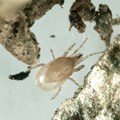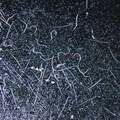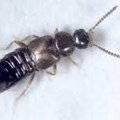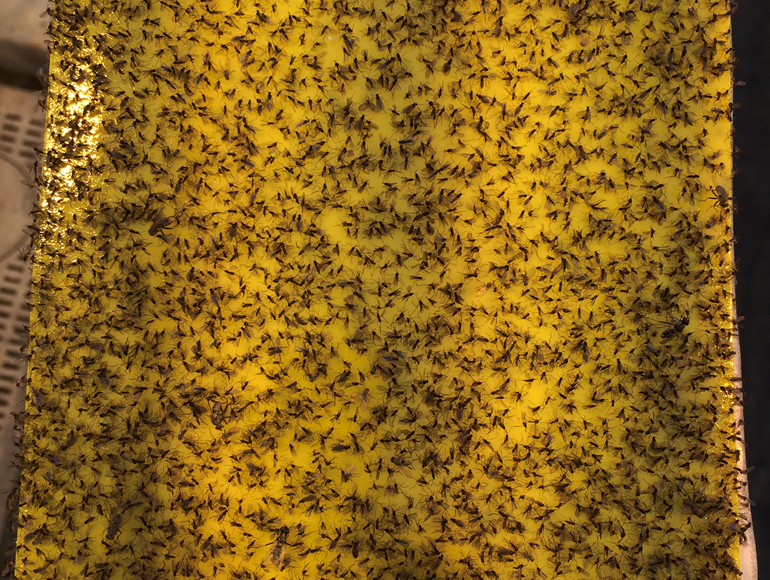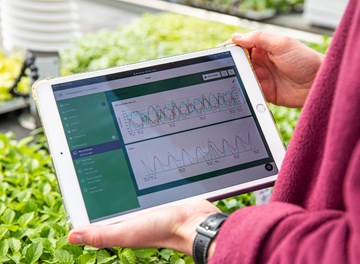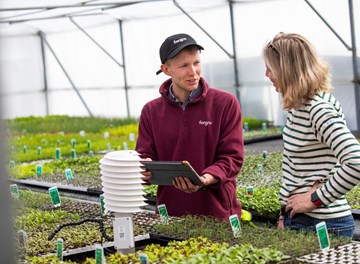
Sciarid flies are a usually an issue within propagation and interior growing areas as they are encouraged by wet conditions where decomposition and decay may be occurring.
Adult sciarid flies tend to feed on spores or decaying pant material, however, they can also attack plant roots and burrow up into stems (especially on Forsythia and Poinsettia).
Find out more about our sciarid fly controls
This species is a soil dwelling mite and predates on the larval stages of sciarid, moving down to approximately 3cm into the soil depending on how compact the soil is and requires a minimum temperature of 12˚C for activity. This predator is best used as a preventative control and when sciarid is at low populations and applied at 3-4 weekly introductions through high-risk times in the season.
If sciarid populations are high a nematode application should be considered to knock populations down and then following up with introductions of Hypoaspis later on when the pest pressure is reduced.
Application instructions:
• Rotate the tube several-times before opening the mix contents
• Remove the cap from one end of the tube (either end)
• Shake tube slowly to dispense mixture onto the surface of the growing media
• Mites will quickly distribute uniformly through the plants
Pack sizes available:
• FGGRB Hypoline M (Hypoaspis miles) Tube of 10,000 Mites
• FGGNA Hypoline M (Hypoaspis miles) Tube of 25,000 Mites
• FGGRC Hypoline M (Hypoaspis miles) Bag of 125,000 Mites
This is a predatory nematode species and is very effective at knocking down sciarid fly populations quickly. When the nematodes are applied as a drench to the soil, they seek out the sciarid and enter the host, they then release a bacteria that starts to break the host down from the inside creating a food source for the nematodes. The nematodes reproduce within the host and once in high enough numbers and when the food source is depleted they then evacuate and seek out further hosts.
Optimum soil temperatures for this species is between 14-25˚C and it is essential the soil you are applying the nematodes to is not dry as they require a film of moisture to move through and if allowed to dry out then the nematodes will die. Persistence in the soil is approximately 4-6 weeks if conditions are kept favourable for the nematodes and application frequency should be the same if solely nematodes are being applied as a control.
Ensuring filters less than 1mm are removed to stop the nematodes backing up they can be applied through irrigation lines, this includes through the irrigation lines of living walls, some living walls are not suitable for applying nematodes through so please get in contact if you need further advice on application through irrigation on living walls. If new plants are coming onto site as a precautionary application or if sciarid fly populations are present in high numbers, we recommend to apply this nematode species first.
Application instructions:
For spray application - empty packs into a large bucket, then add water at the temperature of approx. 21˚C and mix thoroughly.
• Rinse bucket contents into sprayer tank using the standard spray tank sieve.
• Add the required volume of additional water to the sprayer, gently agitate the contents of the spray tank during application.
• Maintain until spraying is completed.
• Once nematodes have been mixed with water, use immediately.
• Effectiveness may be improved by adding a wetting agent.
• Remove all fine filters less than one millimetre, including those in the nozzles, from the sprayer.
• Use a large droplet to provide a coarse spray pattern.
• For ornamentals under cover, spray onto growing media around plant roots.
• After growing media applications the area should be lightly irrigated from above to wash the nematodes into the growing media.
• Do not soak the growing media, as this will cause the nematodes to wash out of the pots.
Avoid mixing with pesticides and adjuvants unless they have been compatibility checked. Do not mix with fertilisers but instead apply a fertiliser before of after nematode application.
For sciarid fly control, apply every 2-6 weeks, the entire solution should be applied once mixed within 4 hours.
Pack sizes available:
• Steinernema feltiae tray of 6 million
• Steinernema feltiae tray of 50million
• Steinernema feltiae tray of 50million x5
• Steinernema feltiae tray of 250million
• Steinernema feltiae tray of 250million x5
This species is a soil roving predator controlling a range of soil dwelling pests including sciarid larvae. They are very mobile with their ability to fly and are active at a broad range of temperatures with the minimum approximate temperature for activity of 12˚C.
This is an effective predator however, within an internal landscape situation such as an office this might not be the first choice as the beetles are between 2-3mm long and despite them keeping relatively hidden in the soil media their size and high populations when introduced could be noticed by the public. If this is a concern it would be best to look towards the more discreet predator mites and nematodes.
They come as a loose formulation of adults and larvae to disperse or as a breeding colony in a bucket, with the bucket containing food and instructions of how to maintain it and how often to apply food and water.
Application instructions:
• Rotate the tube several times before opening to mix the contents.
• Push the cut-out on the lid where marked to open the tube.
• Rotate the lid cover to the fully open position for application.
• Shake contents gently onto soil media and anywhere you expect the sciarid larvae to be.
Pack sizes available:
FGATH Staphyline AC (Atheta coriaria) Tube of 500 larvae/adults
FGATG Staphyline AC (Atheta coriaria) 6lt tub of 3,000 larvae/adults
FGATA Staphyline AC (Atheta coriaria) Breeder bucket system
